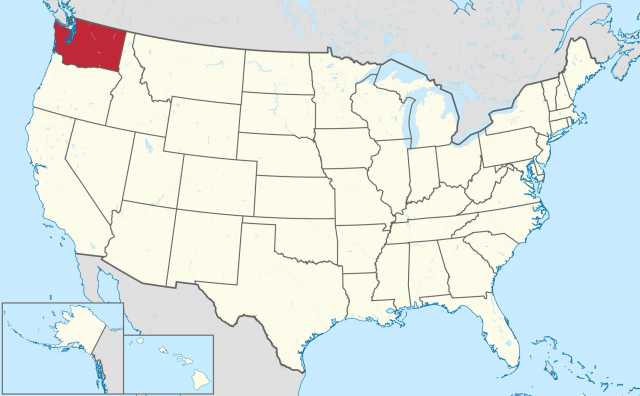Washington
THE STATE OF WASHINGTON in the northwest UNITED STATES has an area of 71,303 square mi (184,674 square km) and a population of 5,894,121 (2000). Bordered by OREGON to the south and CANADA to the north, Washington State boasts a dramatic range of geographic diversity, including dense forests, mountain ranges, an ocean coast, and arid farmland. The capital is Olympia and the highest point is Mount Rainier, at 14,410 ft (4,392 m).
The state can be divided into six distinct geographic areas, three of which are tremendously mountainous: the Olympic Mountains, the Coast Range, the Puget Sound Lowlands, the Cascade Mountains, the Columbia Plateau, and the ROCKY MOUNTAINS.

The westernmost geographic area, the Olympic Mountains, is bordered by the PACIFIC OCEAN and, to the north, the Straight of Juan de Fuca. The bulk of this area lies within the protected borders of the Olympic National Park, much of which is inaccessible and preserved as wilderness areas. This region of the state includes Mount Olympus, the highest peak in this region, at (7,954 ft or 2,424 m). Further down the western coast are the Willapa Hills, some of the lowest mountains on the Pacific Coast. To the east lie the Cascade Mountains, forming a 700-mi (1,126-km) chain that encompasses the highest point in Washington, Mount Rainier, as well as several other high volcanic peaks, including Mount Adams (12,307 ft or 3,751 m), Mount Baker (10,778 ft or 3,285 m), and Glacier Peak (10,541 ft or 3,212 m). Also notably included in this chain of mountains is Mount St. Helens, which famously erupted in 1980. Finally, the Rocky Mountains run through the northeast corner of Washington State.
Both the Puget Sound Lowlands and the Columbia Plateau contain much of the state's farming and agricultural lands (Washington State contains approximately 37,000 farms). While wheat is one of the state's prime income-producing crops, Washington is also known for its fruits, being the country's leading producer of apples. The Columbia Plateau itself is crossed by both the Columbia River, running along the border between Washington and Oregon, and the Snake River. Prior to colonization, Washington State was inhabited by a variety of Native American tribes, including the Nez Perce, Yakima, Nooksak, Chinook, Nisqually, and Quinault, among others. (Approximately 30 registered Native American tribes continue to call Washington State home, with reservations found throughout the state.)
In 1775, however, Spanish explorers reached Washington State, claiming it for SPAIN. Explorers LEWIS AND CLARK followed shortly thereafter, following the Snake and Columbia rivers to the Pacific Ocean. Through a series of trade and settlement agreements, ownership of Washington changed hands several times, including a period of time (from 1818–46) when Washington State was jointly owned by the UNITED STATES and Great Britain. Washington eventually became an independent territory in 1853. Following the completion of the Northern Pacific and Great Northern rail lines, on November 11, 1889, Washington became the 42nd state to join the Union.
Washington's early industry revolved around agriculture and lumbering. With the construction and growth of the transcontinental railroad (and the entire railroad industry), not only did the lumber industry grow, but transportation (shipping) took on an increasingly important role. Recent history has seen the growth (and subsequent decline) in the computer and software industry, based in large part in the greater Puget Sound area around Seattle and Redmond (home to Microsoft). This time period (1970s–80s) also saw a tremendous population boom, particularly in the greater Puget Sound area. Contemporary Washington industry continues to revolve around software and computer technology, as well as aviation and agriculture.